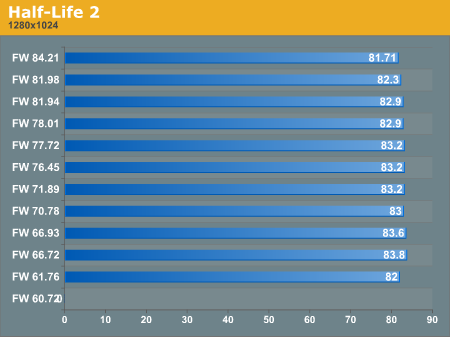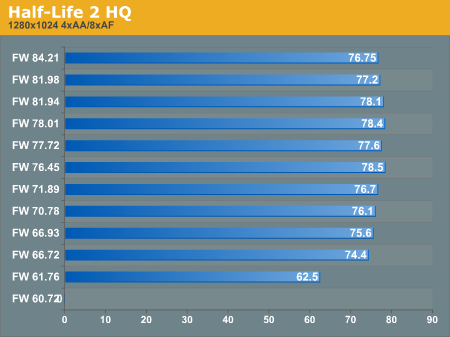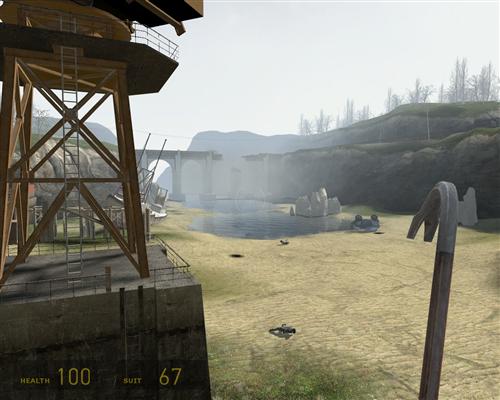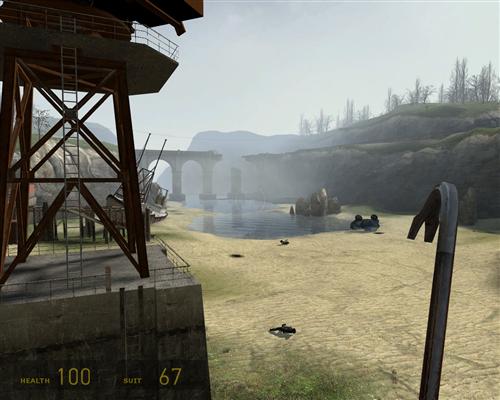Looking Back Pt. 3: The 6800 Ultra, ForceWare, and the Future
by Ryan Smith on May 11, 2006 4:00 AM EST- Posted in
- GPUs
Half-Life 2
Here is another game where NVIDIA has at least started out with a performance disadvantage, as we noted in our Half-Life 2 GPU Roundup back in 2004. With the immense popularity of Half-Life 2 and the Source engine being licensed out for use in other games, this is another game where there is a good deal of pressure on NVIDIA to find a way to improve performance.


As you can see here, there is a pattern forming with the 60.72 drivers. We've had to once again had to drop the 60.72 results due to some rendering errors. The image is far too bright with the initial drivers, and there are other problems as well.

ForceWare 60.72 versus 84.21
Mouse over for 84.21
Throwing the 60.72 drivers out, we can see NVIDIA worked in one significant performance boost, a much needed 20% under HQ settings. NVIDIA further adds around another 5% over the rest of the life of the ForceWare drivers, but nothing nearly as significant as with the initial performance boost.

ForceWare 61.76 versus 84.21
Mouse over for 84.21
The 6800 Ultra once again comes up clean in the image quality comparisons. With blowing fog, these two screenshots are not perfectly alike, but looking at the other parts of the screenshot shows them to be essentially identical.










24 Comments
View All Comments
z3R0C00L - Thursday, May 11, 2006 - link
Forgot to mention another fact..nVIDIA releases BETA drivers on a regular basis (usually not too stable and still plagued with issues that may fix a few issues in certain games but break others.. of course they're BETA).
ATi release WHQL drivers each month. A new set is release on a monthly basis, usually with MANY bug fixes. ATi is better at fixing issues quicker then nVIDIA. nVIDIA releases a WHQL'd driver once every soo often (like 4 times a year.. maybe up to 6 if lucky).
This means most nVIDIA users run BETA, non tested drivers. You're the guinea pigs. ATi at least rigourously test each release and even have a 3rd party corporation (Microsoft) test them and certify them. This is a commitment to the utmost quality in drivers.
So those who complain of ATi driver's are quite honestly liars (they probably own competitor cards and suffer from a disease known as fanboyism).
These are FACTS. Call me a fanboy for posting FACTS.. it's ok.. Anandtech knows it's true, as do HardOCP, Tom's Hardware, Elitebastards and Beyond 3D.
Before I leave I want to post another FACT. nVIDIA's OpenGL drivers remain top dog. This is NOT because they code the drivers better. It's because nVIDIA own more OpenGL extension patents that are more widely used by OpenGL game dev's. Most Dev's use nVIDIA OpenGL paths then ATi paths. Forcing ATi to either use a path optimised for nVIDIA cards or a generic path. This is partly ATi's fault for not creating there own path and pushing dev's to use them.
There... the FACTS. ;)
gamara - Wednesday, May 17, 2006 - link
There are always fewer bugs to fix in less buggy code. If ATI got it right the first time in more cases, maybe their bug fix total wouldn't be as high. I have to agree with another poster on having several issues with ATI drivers in some games and not having anywhere near the same number of issues with beta drivers from nVidia. I had more issues with drivers on a single ATI card than on my Riva TNT, GeForce2, GeForce4, FX5600 Ultra, 6600GT, and 7800GTX combined.Ryan Smith - Thursday, May 11, 2006 - link
You have the right idea, but the wrong terminology. In the past, Nvidia has only released around 4 official drivers a year, compared to ATI's 12(though recently have since then been releasing more often). However, they submit many more drivers for WHQL certification than those 4 drivers; usually any "beta" drivers they officially release are already WHQL certified. Unlike ATI there are non-certified drivers out there too since Nvidia shares its drivers more freely with its OEM partners than ATI, and hence you'll see a leak now and then, but for the most part Nvidia drivers are WHQL certified. In fact for this article, I reference the following:
However given the simply enormous number of such drivers, we used only Windows Hardware Quality Labs (WHQL) certified drivers, which means these are drivers NVIDIA was confident enough to release in a final form and submit to testing to Microsoft.
Wesleyrpg - Thursday, May 11, 2006 - link
hey there,you guys mention FFXI tests on page 3, but theres no results on any of the pages? whats up with that?
Wesleyrpg - Thursday, May 11, 2006 - link
whoops....its under console portsRyan Smith - Thursday, May 11, 2006 - link
Sorry about that, it's been made clearer now. Karen is on vacation, and it's more or less the worst kept secret in the world that we're terrible bachelors when it comes to writing.etriky - Thursday, May 11, 2006 - link
The reason ATI has been able to get large increases in their drivers is their first ones are terrible. I'll be the first to admit they make very good hardware. But their control panel is annoyingly bloated and driver stability is terrible. My hat's off to people that will put up with their software.Griswold - Thursday, May 11, 2006 - link
The usual humbug. The only thing I can agree with is that CCC is unwanted bloatware. Besides that, ATIs drivers are excellent and that is coming from a current nvidia user (though I still have an old box with my trusty 9700 pro and I've enjoyed catalysts ever since I bought this card a few months after its launch).Spoonbender - Thursday, May 11, 2006 - link
Currently they are, yes. But some years back, they sucked.I think the article neglects to mention the possibilty that maybe NVidia's drivers were just better optimized to begin with? If that's the case, ATI has "merely" been catching up.
I don't even find it unlikely. Today, both ATI and NVidia has great drivers (although some find the ATI control panel a bit bloated, but that's hardly a *driver* issue)
But, say, 5 years ago, ATI just couldn't make drivers, while NVidia were about as good as they are today. So ATI has obviously been catching up, and obviously, the scores in this article reflect that. ATI has just had more room for optimizing because they started at a disadvantage.
So I'm not sure I agree with the article that "ATI is the victor for getting the most out of its drivers." That's only true if we assume they were even when they started out.
However, one final thought. It's pretty clear that if you want an accurate picture of performance, you should wait at least two driver revisions from launch. Seems to more or less stabilize after that. So is there any chance, with future hardware releases, that you're going to revisit them after, say, two driver updates? Would be interesting to say the least.
Griswold - Friday, May 12, 2006 - link
I was talking about a few years back. I didnt buy that 9700 last year. I bought it at the end of 2002. It was launched in august 2002. And I've never had any issues with ATIs drivers with that card to this very day. YMMV but you wont hear me say "they suck" for an obivious reason.